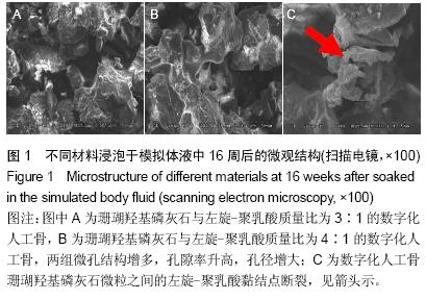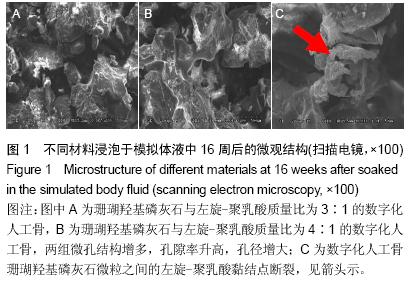| [1] Tanner KE.Bioactive composites for bone tissue engineering. Proc Inst Mech Eng H.2010;224(12):1359-1372.
[2] Zhao Z,Jiang D. Progress and prospect of synthetic biodegradable polymers for bone repair and reconstruction. Zhongguo Xiu Fu Chong Jian Wai Ke Za Zhi. 2010; 24 (3): 363-367.
[3] 林山,尹庆水,张余,等.数字化珊瑚羟基磷灰石人工骨的制备及性能研究[J].中国矫形外科杂志,2010,18(24):2082-2086.
[4] 林山,尹庆水,张余,等.数字化珊瑚羟基磷灰石人工骨的研制及体外细胞毒性研究[J].中国骨与关节损伤杂志, 2011, 26 (2): 121 -124.
[5] 林山,黄晓梅,芮钢,等.数字化珊瑚羟基磷灰石人工骨的致敏实验[J].中国组织工程研究,2014,18(25):3961-3965.
[6] Kokubo T,Takadama H. How useful is SBF in predicting in vivo bone bioactivity? Biomaterials.2006;27(15):2907-2915.
[7] Noeh FM,Wenzel A,Harris N,et al. The effects of arginine administration on the levels of arginine, other aminoacids and related aminocompounds in the plasma, heart, aorta, vena cava, bronchi and pancreas of the rat.Life Sci. 1996;58(8): 131-138.
[8] Czako I,Takacs T,Varge IS,et al.The pathogenesis of Lateinine-induced acute necrotizing pancreatitis Inflamm atory mediators and endogenous cholecystokin.J Physiol Paris.2000;94(1):43-50.
[9] Daniels AU,Chang MK,Andriano KP.Mechanical properties of biodegradable polymers and composites proposed for internal fixation of bone. J Appl Biomater.1990;1:57-78.
[10] David A,Eitenmuller J,Von Oepen R,et al.Mechanical strength and chemical stability of biodegradable block-polymerized and injection molded poly-L-lactide in vitro. Unfallchirurg. 1994;97:278-284.
[11] Shikinami Y,Matsusue Y,Nakamura T.The complete process of bioresorption and bone replacement using devices made of forged composites of raw hydroxyapatite particles/poly l-lactide (F-u-HA/PLLA).Biomaterials.2005;26:5542-5551.
[12] Prokop A,Hofl A,Hellmich M,et al.Degradation of poly -L/DL -lactide versus TCP composite pins: a three-year animal study.J Biomed Mater Res B Appl Biomater. 2005; 75 (2): 304-310.
[13] Yeo A,Rai B,Sju E,et al.The degradation profile of novel, bioresorbable PCL-TCP scaffolds: An in vitro and in vivo study.J Biomed Mater Res A.2008;84(1):208-218.
[14] Hak DJ.The use of osteoconductive bone graft substitutes in orthopaedic trauma. J Am Acad Orthop Surg. 2007; 15 (9): 525-536.
[15] Ducheyne P,Radin S,King L.The effect of calcium phosphate ceramic composition and structure on in vitro behavior. I. Dissolution.J Biomed Mater Res.1993;27(1):25-34.
[16] Deed ME,Tompach PC,Morstad AT. Porous hydroxylapatitegranules blocks as alveolar ridge augmentation materials: a preliminary report.J OralMaxillofac Surg.1988;46(11):955-970.
[17] Kang YQ,Xu XJ,Yin GG,et al.A comparative study of the in vitro degradation of poly(L-lactic acid)/β-tricalcium phosphate scaffold in staticand dynamic simulated body fluid. Eur Polym J.2007;43:1768-1778.
[18] Cheung HY,Lau KT,Lu TP,et al. A critical review on poly-mer-based bio-engineered materials for scaffold development.Composites: Part B.2007;38:291-300.
[19] Thomas MV,Puleo DA,Al-sabbagh M. Calcium sulfate: a review.J Long Term Eff Med Implants.2005;15(6):599-607.
[20] Ye J,Gao Q,He JJ,et al.Exposure rate of unwrapped hydroxyapatite orbital implants in enucleation surgery.Br J Ophthalmol.2015.pii: bjophthalmol-2015-307412. doi: 10.1136/bjophthalmol-2015-307412.[Epub ahead of print]
[21] Gradinaru S,Popescu V,Leasu C,et al.Hydroxyapatite ocular implant and non-integrated implants in eviscerated patients.J Med Life.2015;8(1):90-93.
[22] Xue Y,Zhang H,Che Y,et al.Effect of parathyroid hormone (1-34) and coralline hydroxyapatite on bone regeneration of peri-implant bone defects.Zhonghua Kou Qiang Yi Xue Za Zhi. 2015;50(2): 99-102.
[23] Du B,Liu W,Deng Y,et al.Angiogenesis and bone regeneration of porous nano-hydroxyapatite/coralline blocks coated with rhVEGF165 in critical-size alveolar bone defects in vivo.Int J Nanomedicine.2015;10:2555-2565.
[24] Georgiannos D,Lampridis V,Bisbinas I.Phenolization and coralline hydroxyapatite grafting following meticulous curettage for the treatment of enchondroma of the hand. A case series of 82 patients with 5-year follow-up.Hand (N Y). 2015;10(1):111-115.
[25] Wei Q,Lu J,Wang Q,et al.Novel synthesis strategy for composite hydrogel of collagen/hydroxyapatite-microsphere originating from conversion of CaCO3 templates. Nanotechnology. 2015;26(11):115605.
[26] Nandi SK,Kundu B,Mukherjee J,et al.Converted marine coral hydroxyapatite implants with growth factors: in vivo bone regeneration.Mater Sci Eng C Mater Biol Appl. 2015;49: 816-823.
[27] Aggarwal H,Kumar P,Singh RD,et al.Ocular rehabilitation following socket reconstruction with amniotic membrane transplantation with failed primary hydroxyapatite implant post enucleation.Cont Lens Anterior Eye. 2015;38(1):64-69.
[28] Fu K,Xu Q,Czernuszka J,et al.Characterization of a biodegradable coralline hydroxyapatite/calcium carbonate composite and its clinical implementation.Biomed Mater. 2013;8(6):065007.
[29] Monchau F,Hivart P,Genestie B,et al.Calcite as a bone substitute. Comparison with hydroxyapatite and tricalcium phosphate with regard to the osteoblastic activity.Mater Sci Eng C Mater Biol Appl.2013;33(1):490-498.
[30] Chou J,Austin C,Doble P,et al.Trace elemental imaging of coralline hydroxyapatite by laser-ablation inductively coupled plasma-mass spectroscopy.J Tissue Eng Regen Med. 2014; 8(7):515-520.
[31] Baas J,Svaneby D,Jensen TB,et al.Coralline hydroxyapatite granules inferior to morselized allograft around uncemented porous Ti implants: unchanged fixation by addition of concentrated autologous bone marrow aspirate.J Biomed Mater Res A. 2011;99(1):9-15.
[32] Figueroa RJ,Koch TG,Betts DH.Osteogenic differentiation of equine cord blood multipotent mesenchymal stromal cells within coralline hydroxyapatite scaffolds in vitro.Vet Comp Orthop Traumatol.2011;24(5):354-362. |











